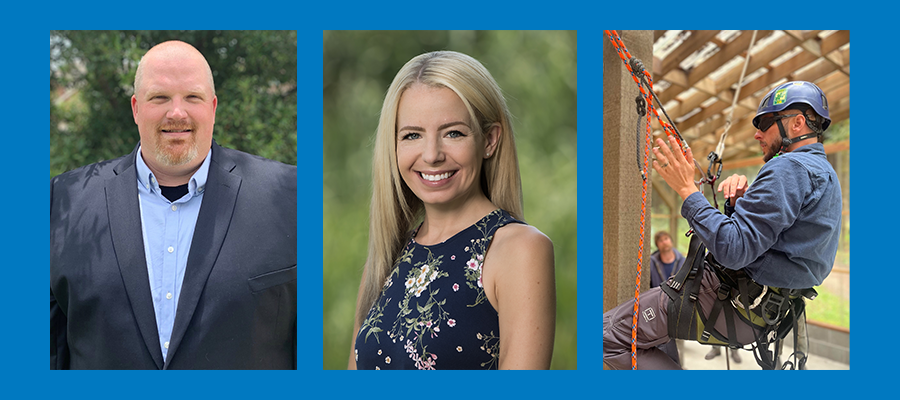- Vegetation Management Services
- Industries
- In Your Neighborhood
- About
- Careers
- Webinars
- Articles
How Our Industry is Changing

The utility services industry is moving in new directions — not only as the industry itself develops new processes and technologies, but also as shifting climate conditions and an increasingly complex regulatory environment create a cycle of cause-and-effect. This cycle has been producing more and more scenarios and circumstances that require utilities and the companies that work with utilities to adapt to keep pace.
While the industry is facing significant change both now and in the years to come, it also faces an equal amount of misunderstanding — both in the public and professional spheres. Members of the Utility Arborist Association (UAA) will understand the misconceptions we collectively face: that the association focuses exclusively on vegetation-related matters — when utilities and the companies that support them face more challenges than just vegetation management. An additional misconception is that only electric utilities face these challenges, when water, gas, and other service providers must also navigate them.
A Shifting Climate Impacts More Than Weather
For example, recent years have seen an increase in severe weather and storms — resulting in damage to utility property such as power, water, and gas lines; customer complaints and public relations issues; and a race against the clock to meet tight compliance timelines. Everything from hurricanes and wind storms to heavy snowfall and ice storms threatens utilities’ ability to provide reliable service to tens or even hundreds of thousands of customers. Needless to say, these events and circumstances necessitate an immediate response, not only to restore service to customers’ homes and businesses but also to help utilities avoid regulatory fines and costly litigation as a result of prolonged service outages.
Not all extreme weather events involve storms. Often, the impact made in an area over a period of long-term climate change can lead to situations that also require a response — and the more proactive, the better. In certain areas of the country, extended drought can lead to a widespread infestation of harmful insects such as bark beetles. Dead and dying vegetation poses a risk to all utilities — not just power companies. Water lines and gas lines are all subject to damage from vegetation.
When incidents such as drought and infestation occur, the need to understand the extent of the risk potential — as well as the remediation process — is critical and timely. We partner with utilities of all types to assess affected areas and develop a strategy and process for mitigation and resolution. This includes identification and cataloging of vegetation in affected areas and coordinating removal or other tasks with contracted work crews.
The Storm That Follows the Storm
While storms, extreme weather, droughts, and infestation pose field-level challenges for utilities of all types across the country, a potentially greater problem is the repercussions of failing to prevent, mitigate, contain, resolve, and communicate situations should they arise. Failure to address certain incidents can quickly lead to multi-million-dollar fines and regulatory action taken against not only the responsible party but also the industry itself.
Utilities and other industry organizations are well aware of the many compliance requirements. These regulations undergo frequent re-evaluation and updates, requiring the industry to adapt and often in very short order. In this heavily regulated and increasingly litigious environment, the value of working with an independent third party for compliance support cannot be understated. Much is at stake, and industry organizations already shoulder the burden of providing reliable service to customers. Internal compliance and legal teams are standard, but supporting those teams with an expert, independent partner serves to validate decision-making, evaluate and improve internal processes and procedures, and get organizations in the best position possible to do what they do best with as little risk as possible.
And while the goal of such services is to help utilities avoid legal proceedings, expert witness testimony through an independent third-party can provide the reliable, external perspective that may be needed in a legal scenario if the time should come. This is often the case in safety-related matters, where accidents and incidents that are often preventable nonetheless occurred, putting the utility at risk of a lawsuit.
A Strong Safety Program Starts with Safety-Conscious People
Safety has always been a priority for the industry, but ever since tragic accidents in the 1960s spurred the development of the ANSI Z133 Safety Standard, the emphasis on safety has only continued to grow. Safety plays a significant role in the protection of an organization’s bottom line, as workers’ compensation claims, insurance premium increases, legal costs, and other results of preventable incidents make an immediate and long-term financial impact.
Safety is deeply ingrained in our culture and the services we provide. To help the industry build and maintain safety-conscious cultures that keep employees, contractors, and customers safe at all times, provide a variety of services that cover all levels of an organization’s safety program.
A safety program gap analysis evaluates onboarding and new hire training processes, program materials and safety tailgates, safety manuals, and training documentation, and incident reporting and investigation procedures. Interviews are conducted with key personnel and management, while work crews are audited in the field to better understand the nature of their day-to-day activities. The entire analysis is performed through our independent perspective that focuses on safety, and safety alone.
Once complete, a report is provided detailing all areas of review and analysis, highlighting areas where the organization is performing well and items that can be leveraged to strengthen the safety culture. Improvement areas are examined, and recommendations are made as it relates to deficiencies in internal reporting, training, and other gaps in the overall effort to develop and maintain a best-in-class safety program.
While a safety program is an absolute requirement for every organization in the utility services industry, simply having one does not guarantee that it is being followed. Ensuring that workers in the field are following best safety practices is an ongoing effort, as busyness, lack of training, or other problems can lead to workers potentially taking shortcuts and putting themselves — or others — at risk of injury.
Company-wide field worker assessment skills and a competency evaluation can help the industry ensure safety practices are being followed. This service helps to enhance safety, increase employee engagement, bolster morale, and provide third-party training and feedback. Crews are observed and scored according to workplace and worksite safety protocol, and assessments are evaluated based on industry best management practices.
Are You in Position to Respond to Change?
As the world experiences and adapts to climate change, as the industry adapts to shifting and increasing regulation, and as the emphasis on safety both externally and internally continues to grow, we encourage the industry to consider two things. First, get involved. The UAA reaches more than the vegetation management space. Its work with utilities and industry organizations of all types can only grow and improve with participation. Second, consider how your organization is responding to change now, and how it is positioned to respond in the future. Industries, governments, and the very world around us are all in a constant state of change — how will you best prepare?
Bob Urban is the Senior Manager with ACRT. Bob oversees the business development efforts in the West region of the United States. Bob has served over twenty years in various roles with ACRT including field Supervisor, Operations Manager and Director of Operations for the western region. He holds an associate’s degree in Arboriculture from Paul Smith’s College and is an ISA Certified Arborist and Utility Specialist.
View this article as it appeared in Utility Arborist Newsline
Related Articles

Servant Leadership in Utility Vegetation Management By C. Troy Ross, President, ACRT and ACRT Pacific On a chilly Monday morning, a utility vegetation management crew gathers for their weekly briefing. Instead of launching into instructions, their supervisor begins by asking each team member how they’re doing. One mentions a child’s illness, another shares excitement about[...]
Read More
Turning Vegetation Waste into Opportunity By Aana Agrawal, Sustainability and Resilience Manager, EnviroScience The utility vegetation management (UVM) sector plays a crucial role in ensuring the smooth transmission of power across regions and cities by keeping plant growth under control within the vicinity of transmission and distribution lines. However, unrefined vegetation maintenance practices often focus[...]
Read More
Reflections from Will Nutter Silver Shield Award Recipients By Bob Urban, Senior Manager, ACRT Services In an industry where the stakes are high and every decision can have life-altering consequences, leadership in utility arboriculture isn’t just a managerial function; it’s a calling. Nowhere is this more evident than in the recipients of the Will Nutter[...]
Read More
The Electric Butterfly: Reconnecting with Nature on the Edges By Ryan Meccage, Business Development Manager, ACRT Services In an age dominated by smartphones, constant connectivity, and algorithm-driven content, we’ve never been more digitally immersed. Yet somehow, we’ve also never felt so far removed from the natural world beneath our feet. The urge to step away[...]
Read MoreRecent Posts
- Alex Fields Awarded ACRT Safety Challenge Coin 20th Nov 2025
- Servant Leadership in Utility Vegetation Management 12th Nov 2025
- ACRT Honors Our Veterans 10th Nov 2025
- Anna Davis Awarded Safety Challenge Coin 04th Nov 2025
- ACRT Senior Consulting Utility Forester Recognized as Safety Superstar 15th Oct 2025
Categories
The Leader In Vegetation Management
We are all about people, and we put safety first. Ready to work with our well-trained team?